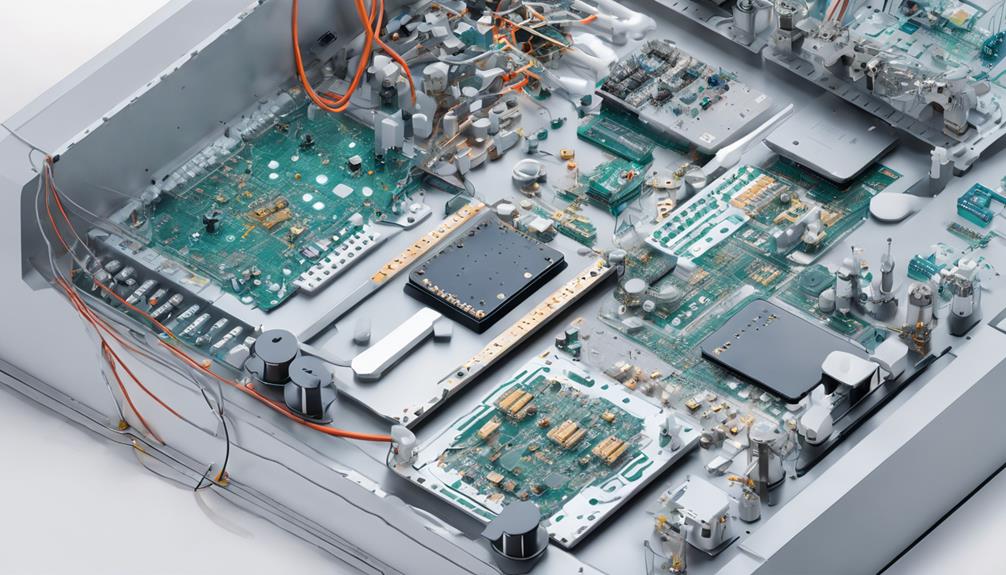Fabrication expenses can be greatly reduced by implementing a combination of strategic design principles, automation solutions, and operational efficiencies that target waste reduction, labor productivity, and supply chain optimization. Effective strategies include optimizing PCB design and automation, streamlining supply chain operations, enhancing labor efficiency, leveraging smart manufacturing technologies, and optimizing facility layout and design. By adopting these strategies, manufacturers can decrease labor costs, minimize material waste, and improve overall productivity. In addition, developing strategic partnerships and enhancing quality control processes can also lead to substantial cost savings. Explore these strategies in-depth to uncover additional opportunities for cost reduction.
Key Takeaways
- Implementing automation solutions can reduce manufacturing costs by 12-18% and labor costs by up to 25%.
- Optimizing supply chain operations through supplier consolidation and lean inventory management can minimize lead times and reduce costs.
- Enhancing labor efficiency through cross-training, lean manufacturing principles, and continuous improvement strategies can reduce labor costs.
- Implementing energy-efficient equipment and renewable energy sources can lead to long-term cost savings and increase productivity.
- Focusing on key products with high demand and eliminating low-performing products can optimize resource allocation and reduce waste.
Optimizing PCB Design for Cost Reduction
By applying design principles that prioritize manufacturability and assembly efficiency, companies can greatly reduce fabrication expenses by minimizing material waste, production time, and labor costs. Optimizing PCB design is an essential step in this process, as it enables manufacturing processes to be streamlined and optimized for cost-effectiveness.
By selecting cost-effective components and reducing unnecessary features in the design, significant cost savings can be achieved. Additionally, implementing design rules for PCB layout can minimize waste and improve production yield, resulting in reduced costs.
In addition, collaborating with fabrication partners early in the design process can help identify cost-saving opportunities and optimizations. By integrating these strategies, companies can reduce material usage, production time, and labor costs, ultimately leading to substantial cost savings.
Effective PCB design optimization is a key factor in reducing fabrication expenses, and by prioritizing manufacturability and assembly efficiency, companies can gain a competitive edge in the manufacturing industry.
Implementing Cost-Effective Automation
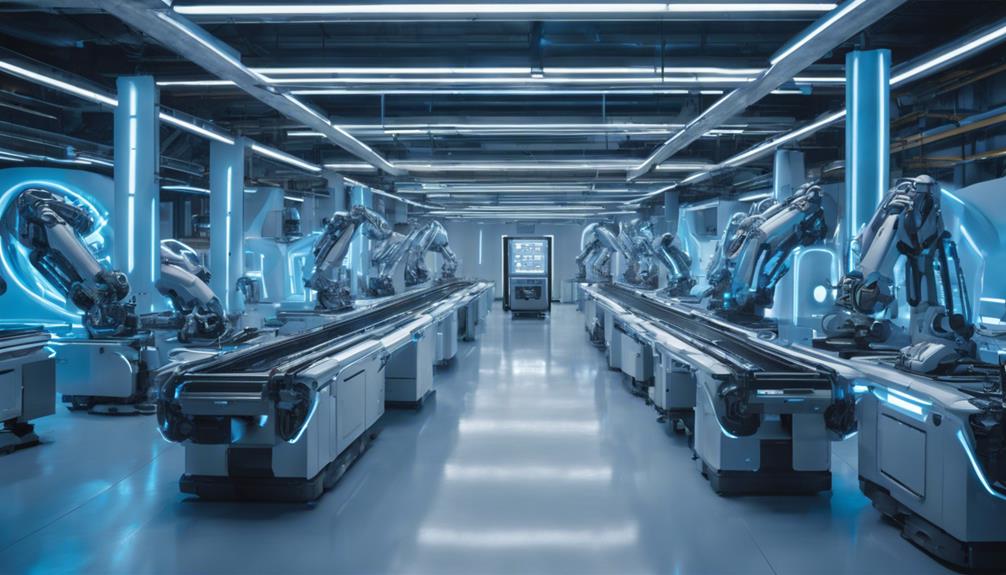
As companies optimize their PCB design for cost reduction, they can further amplify these savings by implementing cost-effective automation solutions that target labor-intensive processes and minimize waste. By doing so, they can reduce manufacturing costs by 12-18% and labor costs by up to 25%. Automation solutions can also lead to a 30-50% decrease in defects and rework expenses, resulting in significant cost savings.
In addition, implementing automation can improve efficiency, leading to a 30% increase in production output. Additionally, automation can lower operational costs by up to 80% through reduced waste and improved efficiency. By adopting cost-effective automation strategies, businesses can reduce labor costs, improve efficiency, and increase productivity by 55%.
Streamlining Supply Chain Operations

Streamlining supply chain operations is a critical component of reducing fabrication expenses. By implementing supplier consolidation strategies, adopting lean inventory management practices, and optimizing logistics routing, manufacturers can greatly decrease costs and improve overall efficiency.
These strategies can help mitigate supply chain complexities, leading to improved production timelines and reduced expenses.
Supplier Consolidation Strategies
In addition, through strategic supplier consolidation, companies can greatly reduce procurement costs and enhance supply chain efficiency by leveraging volume discounts and simplifying communication with a smaller, more reliable supplier base. By consolidating suppliers, companies can optimize inventory management, reducing lead times and minimizing stockouts. This, in turn, enhances supply chain efficiency and reduces costs associated with procurement.
Supplier consolidation also fosters stronger relationships with suppliers, leading to better collaboration, improved quality control, and increased reliability. The procurement process is simplified, reducing administrative overhead, negotiation complexities, and the risk of supply chain disruptions. Moreover, supplier consolidation enables better cost control, improves pricing negotiations, and increases visibility into the entire supply chain for more informed decision-making.
Lean Inventory Management
By adopting lean inventory management practices, companies can greatly reduce excess stock levels and optimize inventory turnover, thereby minimizing storage costs and maximizing supply chain efficiency. This approach involves implementing just-in-time (JIT) inventory practices to guarantee materials are only ordered and used when needed, reducing carrying costs and preventing stockouts. By streamlining supply chain operations, businesses can minimize lead times, improve cash flow, and enhance overall efficiency.
| Benefits | Lean Inventory Management Strategies | Results |
|---|---|---|
| Reducing inventory costs | Implementing JIT practices | Minimizing carrying costs |
| Optimizing processes | Streamlining supply chain operations | Efficiency improvements |
| Improving forecasting | Effective inventory management | Reducing excess inventory |
| Enhancing responsiveness | Implementing lean inventory practices | Better responsiveness to market demands |
| Increasing productivity | Reducing lead times | Cost savings and increased productivity |
Optimized Logistics Routing
Effective logistics routing optimization can greatly reduce transportation costs and enhance supply chain efficiency by leveraging advanced route planning, load optimization, and real-time visibility tools. By implementing optimized logistics routing strategies, companies can minimize delivery delays, reduce transportation costs, and improve overall supply chain performance.
Some key benefits of optimized logistics routing include:
- Up to 20% reduction in transportation costs through efficient route planning and load optimization
- Improved delivery accuracy and reduced manual errors through the use of transportation management systems
- Enhanced supply chain visibility and real-time tracking capabilities through GPS tracking and real-time visibility tools
Additionally, companies can further optimize their logistics operations by collaborating with third-party logistics providers, implementing reverse logistics strategies to recover transportation costs, and optimizing inventory levels to reduce waste and excess inventory. By streamlining their logistics operations, companies can achieve significant cost savings, improve customer satisfaction, and gain a competitive edge in the market.
Enhancing Labor Efficiency Strategies
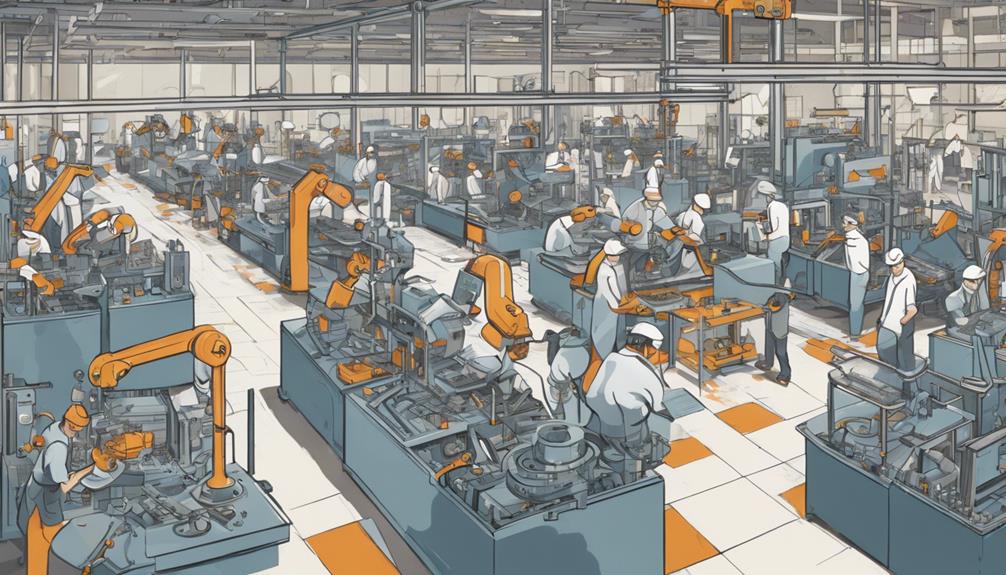
Moreover, prominently in the pursuit of reducing fabrication expenses, one indispensable strategy is to enhance labor efficiency, as even marginal gains in productivity can have a noteworthy impact on a company's bottom line.
Implementing process automation can notably reduce labor costs by improving efficiency and accuracy, freeing up employees for more complex tasks.
Cross-training employees can also enhance labor efficiency by increasing flexibility, avoiding specialized labor costs, and boosting overall workforce skills.
Additionally, adopting lean manufacturing principles can streamline fabrication processes, reduce waste, and optimize efficiency, ultimately leading to significant labor cost savings.
Additionally, employing advanced technologies like robotics and AI can further enhance labor efficiency by decreasing manual labor requirements and increasing overall productivity.
Finally, continuous improvement strategies like Kaizen can empower employees to identify inefficiencies, improve processes, and ultimately reduce labor costs.
Leveraging Smart Manufacturing Technologies

To further augment labor efficiency gains, fabrication companies can leverage smart manufacturing technologies to revolutionize their production processes and reveal additional cost savings. By integrating cutting-edge technologies, such as IoT devices and AI solutions, fabrication companies can optimize their processes, reduce downtime, and streamline production.
Some key benefits of leveraging smart manufacturing technologies include:
- Automation: Implementing automation in fabrication can lead to significant cost savings by streamlining production, reducing labor costs, and minimizing errors.
- Data Analytics: Real-time data analytics enable proactive decision-making to enhance production control and minimize waste in fabrication processes.
- Robotics and Predictive Maintenance: Robotics in fabrication can increase productivity, improve product quality, and reduce operational costs, while predictive maintenance capabilities minimize equipment downtime, reduce repair costs, and prolong the life of fabrication machinery.
Optimizing Energy Efficiency Measures
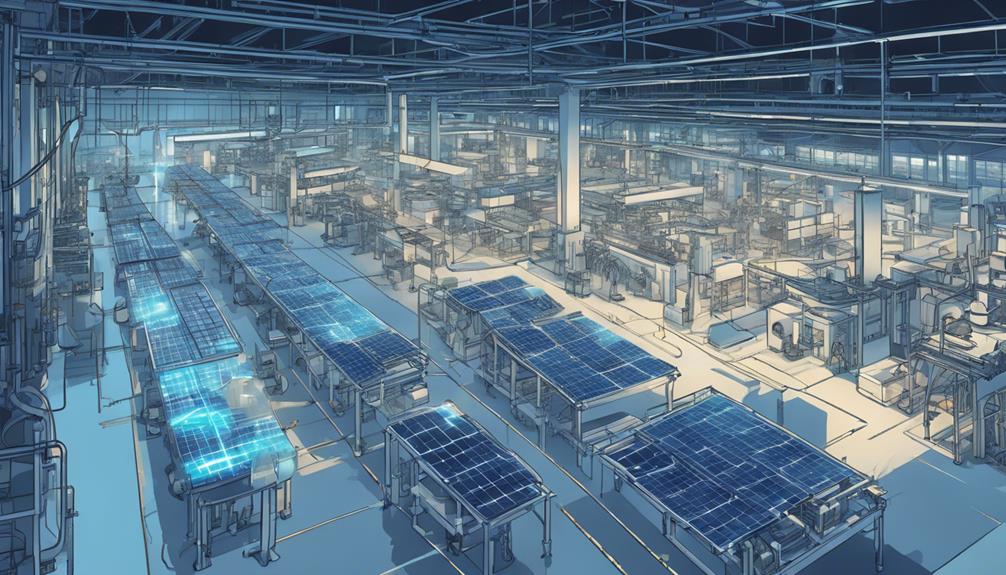
Optimizing energy efficiency measures is essential for fabricators seeking to reduce expenses.
By implementing Energy Monitoring Systems, upgrading machine efficiency, and adopting Lighting Optimization Strategies, fabricators can greatly minimize energy waste and lower operational costs.
These measures can be particularly effective in reducing fabrication expenses, and their implementation is worthy of exploration.
Energy Monitoring Systems
Energy monitoring systems are an essential tool for fabrication facilities seeking to reduce operational costs and improve sustainability by tracking and analyzing energy consumption patterns in real-time. By implementing these systems, fabrication facilities can optimize energy consumption, reduce energy waste, and identify areas for cost savings.
Some key benefits of energy monitoring systems include:
- Providing real-time data on energy usage to identify areas for improvement and cost savings
- Enabling the identification of energy-intensive processes and implementation of energy-saving measures
- Facilitating significant cost reductions in fabrication operations through optimized energy efficiency
Machine Efficiency Upgrades
Machine efficiency upgrades are an essential aspect of cost-effective fabrication, as they can activate significant energy savings and bolster the bottom line by streamlining production processes. By implementing energy-efficient measures, fabrication facilities can reduce energy consumption by up to 30%, resulting in substantial cost savings.
Regular maintenance and calibration of machines are vital in improving energy efficiency and prolonging equipment lifespan. Additionally, utilizing energy management software for real-time monitoring enables the identification of areas for improvement, optimizing energy usage and reducing operational costs.
Investing in renewable energy sources for fabrication processes can lead to long-term cost savings and environmental sustainability benefits. By upgrading machine efficiency, fabrication facilities can reduce energy consumption, lower operational costs, and increase overall efficiency. This not only benefits the bottom line but also contributes to a more sustainable future.
Lighting Optimization Strategies
By complementing machine efficiency upgrades with targeted lighting optimization strategies, fabrication facilities can tap into additional energy savings and further reduce operational expenditures.
Implementing energy-efficient lighting solutions can greatly reduce energy consumption, with LED technology offering up to 75% energy savings compared to traditional lighting systems. This not only reduces manufacturing costs but also contributes to a leaner manufacturing process.
To maximize energy savings, consider the following strategies:
- Retrofit existing lighting fixtures with energy-efficient LEDs to reduce energy bills and maintenance costs
- Implement motion sensors and timers to automatically adjust light levels based on occupancy and natural light conditions
- Utilize daylight harvesting techniques to optimize natural light usage during daylight hours, reducing the need for artificial lighting
Upgrading and Retrofitting Equipment
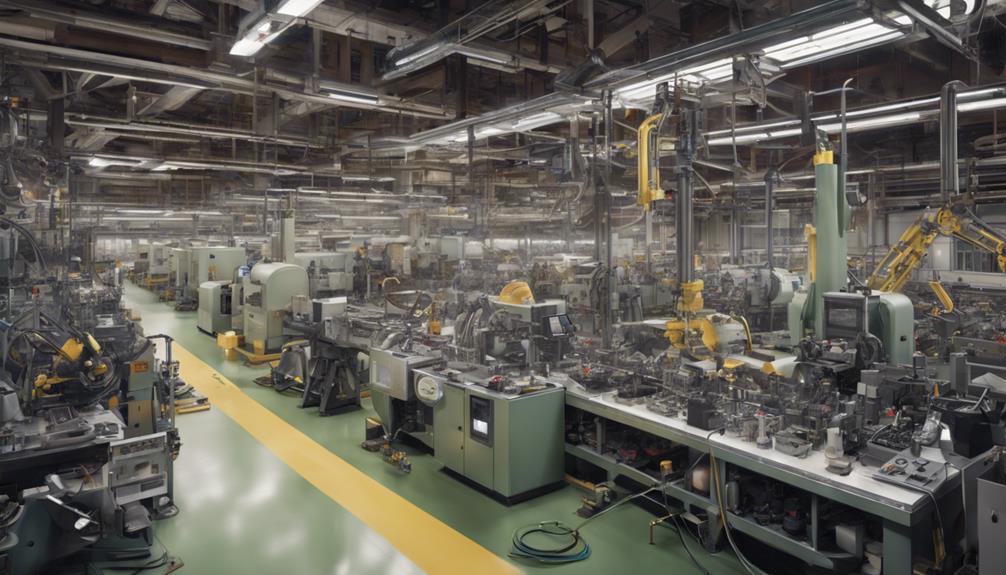
Moreover, stepping up fabrication efficiency can be as straightforward as upgrading and retrofitting existing equipment, a strategic move that can yield significant productivity gains and cost reductions. By upgrading equipment, fabrication facilities can expect a 10-20% increase in productivity and efficiency. This is achieved through the integration of modern technologies and automation, allowing for streamlined processes and reduced labor costs.
Additionally, retrofitting older machinery with new technology can reduce maintenance costs by 25-30%, additionally contributing to cost savings. Modernized equipment also tends to decrease energy consumption by up to 15%, leading to a more sustainable and environmentally friendly operation.
Moreover, upgraded machinery often results in improved product quality and reduced error rates, enhancing overall fabrication performance. By investing in equipment upgrades and retrofits, fabrication facilities can reap long-term cost savings and gain a competitive edge in the industry.
Minimizing Material Waste Strategies
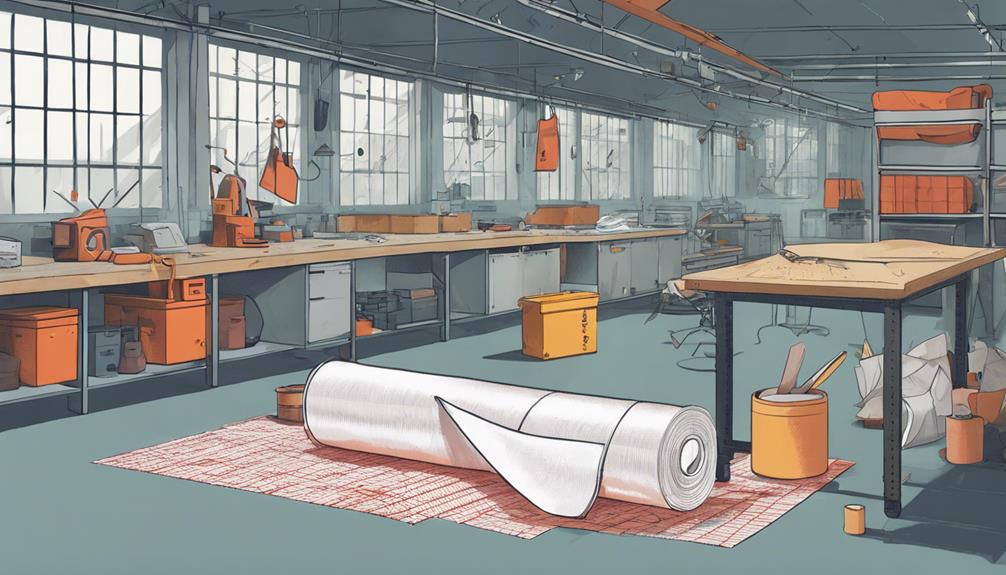
In addition to upgrading and retrofitting equipment, minimizing material waste is a critical aspect of cost-effective fabrication, as unnecessary waste can greatly erode profit margins and undermine operational efficiency. Implementing lean manufacturing principles can substantially reduce material waste, with potential savings of up to 50%.
To achieve this, fabricators can utilize advanced technologies like AI and machine learning to optimize material usage and minimize waste.
Effective waste reduction strategies can lead to substantial cost savings in fabrication expenses. Some key strategies include:
- Streamlining supply chain processes to decrease material waste and improve cost-effectiveness
- Implementing continuous improvement in material handling and storage to reduce waste and improve efficiency
- Utilizing advanced technologies to optimize material usage and minimize waste
Consolidating Product Offerings Effectively

Through strategic product consolidation, fabricators can greatly simplify their operations, eliminate inefficiencies, and access substantial cost savings. By focusing on key products with high demand and profitability, manufacturers can optimize resource allocation and minimize overhead costs. This enables them to streamline operations, reducing production complexity and enhancing overall efficiency.
Moreover, consolidating product offerings allows fabricators to eliminate low-performing or duplicate products, resulting in improved inventory turnover rates and reduced storage expenses. This, in turn, enables them to negotiate better prices and terms with suppliers, leveraging their increased negotiation power.
Optimizing Facility Layout and Design
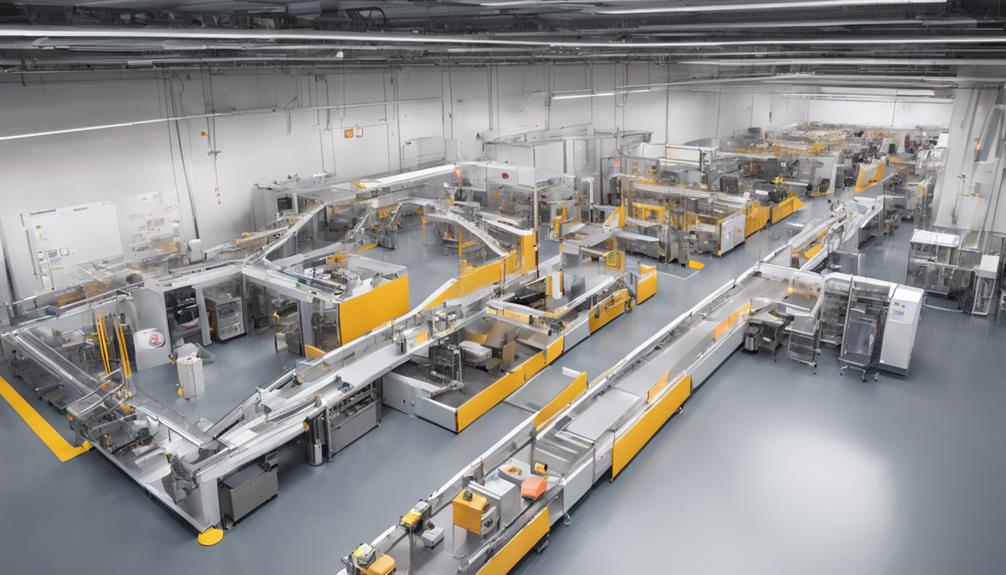
Optimizing facility layout and design is essential for fabricators seeking to reduce expenses and enhance operational efficiency.
By streamlining production flow, minimizing material handling, and maximizing space utilization, manufacturers can greatly reduce waste, increase productivity, and lower costs.
Effective facility design can have a profound impact on a company's bottom line, and careful consideration of these factors is essential for achieving cost-effective fabrication.
Efficient Production Flow
By reconfiguring facility layouts to minimize travel distances and improve workflow efficiency, manufacturers can greatly reduce material handling costs and enhance overall production flow. This optimized layout design enables employees to work more efficiently, reducing the risk of accidents and downtime. As a result, manufacturers can experience significant cost savings and improved productivity.
Some key benefits of efficient production flow include:
- Reduced lead times: By streamlining operations, manufacturers can respond quickly to changing customer demands and reduce lead times, leading to increased customer satisfaction.
- Minimized waste: Implementing lean manufacturing principles in facility design helps eliminate waste, reducing costs and environmental impact.
- Improved facility utilization: Optimizing facility layout and design enables manufacturers to maximize usable space, reducing overhead costs and improving overall efficiency.
Reduced Material Handling
Effective facility layout and design play a pivotal role in reducing material handling costs, as they enable manufacturers to minimize the distance traveled by materials and improve workflow efficiency. By optimizing the layout of workstations and storage areas, manufacturers can greatly reduce the time and costs associated with material handling.
Implementing a streamlined material flow system can also decrease labor requirements and enhance overall productivity in fabrication operations. Additionally, incorporating ergonomic principles in facility design can enhance worker safety and productivity, reducing the risk of injuries and downtime related to material handling.
Investing in automation technologies for material transport and storage can also optimize material handling processes, increasing efficiency and reducing costs. By adopting these strategies, manufacturers can decrease material handling costs, improve workflow efficiency, and create a safer working environment.
Space Utilization Maximization
Facility layout and design have a profound impact on fabrication operations, and maximizing space utilization is critical to reducing material handling costs and enhancing overall efficiency.
By optimizing facility layout, fabrication companies can reduce material handling costs by up to 30%, increase storage capacity by up to 50%, and minimize travel time for employees, thereby boosting productivity.
Some key strategies for maximizing space utilization include:
- Implementing a streamlined facility layout to reduce the risk of accidents and material damage
- Designing a layout that minimizes travel time and maximizes storage capacity
- Utilizing vertical storage solutions to increase storage capacity and reduce floor space usage
Enhancing Quality Control Processes

Regularly incorporating advanced quality control measures into the fabrication process greatly reduces the likelihood of defects and subsequent costly recalls. Implementing automated inspection systems and utilizing advanced imaging technologies for defect detection guarantees product quality and reduces defects. Emphasizing rigorous quality checks prevents defects and improves overall manufacturing efficiency. By preventing defects through systematic quality control measures, manufacturers can reduce waste and save costs.
Implementing lean techniques in quality control processes is essential for waste reduction. This approach eliminates unnecessary steps, reduces variability, and improves process flow. As a result, manufacturers can redirect resources to high-value activities, enhancing productivity and reducing fabrication expenses.
Outsourcing Non-Core Manufacturing Activities

By strategically outsourcing non-core manufacturing activities, companies can redirect resources to high-value tasks, improve overall efficiency, and markedly reduce fabrication expenses. This approach enables businesses to leverage the expertise of specialized service providers, resulting in significant cost savings.
Some key benefits of outsourcing non-core manufacturing activities include:
- Reducing costs by up to 60% compared to in-house production
- Saving up to 30% on operational expenses by outsourcing fabrication tasks
- Improving quality control and reducing production lead times by leveraging external expertise
Developing Strategic Partnerships Effectively
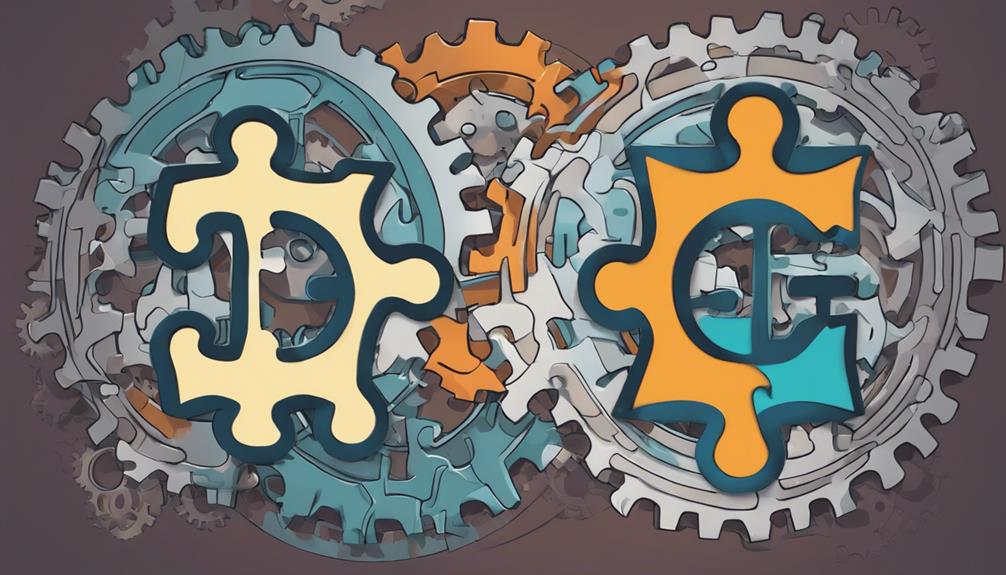
Establishing strategic partnerships with specialized service providers can reveal substantial cost savings and efficiency gains in fabrication, allowing companies to reallocate resources to high-value activities and drive innovation. By collaborating with partners who possess industry-specific expertise, companies can leverage their knowledge and capabilities to reduce fabrication expenses.
Shared resources, including access to specialized equipment and technology, can also be utilized to streamline operations and improve efficiency.
Effective partnerships can be achieved through outsourcing non-core activities to specialized service providers, enabling companies to focus on their core competencies. This collaboration can lead to cost-effective fabrication solutions, improved quality, and accelerated time-to-market.
Additionally, strategic partnerships can facilitate the sharing of best practices, reducing the risk of errors and improving overall process efficiency. By developing strategic partnerships effectively, companies can reap the benefits of cost savings, improved efficiency, and innovation, ultimately gaining a competitive edge in the fabrication industry.
Frequently Asked Questions
How to Cost Reduction in Manufacturing Industry?
To achieve cost reduction in the manufacturing industry, it is essential to implement strategic measures that optimize operational efficiency. This can be achieved by streamlining processes, reducing waste, and leveraging advanced technologies.
What Are the Methods to Reduce the Cost of Production?
To reduce the cost of production, manufacturers can employ several strategies. Implementing lean manufacturing principles eliminates waste and optimizes processes.
Automation and technology integration reduce labor costs and improve efficiency.
Just-in-time inventory management and strategic supplier partnerships minimize material costs.
Optimized production scheduling balances capacity and demand, reducing idle time and setup times.
What Are the Cost Effective Techniques for Production?
To optimize production processes, employ cost-effective techniques such as lean manufacturing, automation, and supply chain streamlining.
Implement process improvements like 5S and Total Productive Maintenance to minimize waste and enhance efficiency.
Leverage advanced technologies like robotics and AI to increase productivity and reduce labor costs.
Additionally, consider nearshoring and strategic sourcing to further minimize expenses, ultimately enhancing the bottom line.
How Can a Manufacturing Firm Minimise the Production Cost?
To minimize production costs, a manufacturing firm can implement process optimization techniques. These include value stream mapping and kaizen events, which help identify and eliminate inefficiencies. Additionally, adopting a total productive maintenance (TPM) approach can reduce equipment downtime and maintenance costs.


